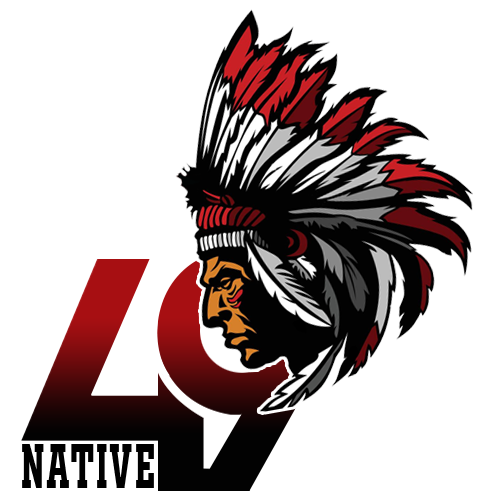Native American Skull Tattoo Designs are not just ink on skin; they are living symbols that encapsulate centuries of wisdom, respect for ancestors, and the enduring spirit of a culture. In this exploration, we delve into the world of Native American Skull Tattoo Designs, uncovering the profound significance and cultural resonance that these captivating designs hold.
From tales of heritage to expressions of strength and resilience, these tattoos tell stories that transcend time and connect us to the heart of Native American traditions.
What does a Native American Indian skull tattoo mean?
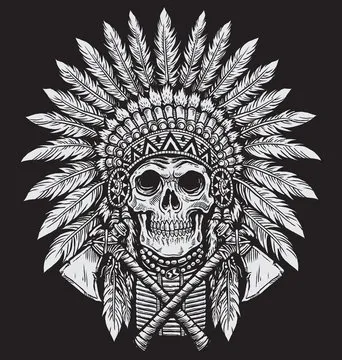
In the world of body art, tattoos have always been more than just ink on skin; they are powerful symbols that convey deep meanings.
Indian skull tattoos, in particular, carry a profound significance that varies among tribes but resonates with themes of respect, pride, leadership, loyalty, and heritage. In this exploration, we delve into the intricate symbolism behind Indian skull tattoos, unearthing their multifaceted meanings that bridge the past and the present.
Honoring Ancestral Heritage
For those with Native American roots, an Indian skull tattoo serves as a unique and heartfelt homage to their tribe’s traditions and the brave warriors who came before them. It’s a way of paying tribute to one’s ancestral lineage, preserving the cultural essence that defines their identity.
The Power of Feathers
One striking element often featured in Indian skull tattoos is the vibrant and intricate headdress adorned with large feathers. These majestic plumes not only add a touch of color and artistry to the design but also symbolize the fierce and intense spirit of the warrior. They are a vivid representation of strength, courage, and the indomitable will to protect one’s people and way of life.
A Connection to Tribal Roots
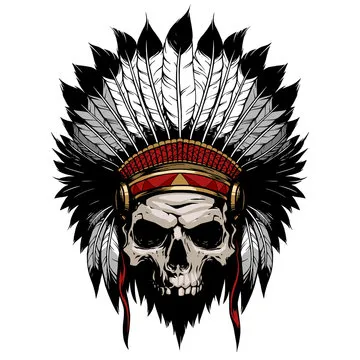
Beyond the individual warrior, Indian skull tattoos establish a deep cultural connection to a specific tribe. Each element of the design, from the choice of feathers to the arrangement of symbols, reflects the unique traditions and history of that tribe. These tattoos are a testament to the enduring fight for survival and identity that Indigenous tribes have faced throughout history.
A Tale of Struggles and Resilience
While Indian skull tattoos embody strength and valor, they also carry a poignant reminder of the challenges and hardships endured by Indigenous communities. The historical backdrop of violence, displacement, and loss of ancestral lands is etched into the very essence of these tattoos. They tell the story of resilience in the face of adversity, a testament to the enduring spirit of Native American people.
Respecting Cultural Appropriation
It’s important to note that the beauty and meaning of Indian skull tattoos come with a responsibility. Cultural sensitivity is paramount when considering such a tattoo. Appropriating these symbols without a genuine connection to Native American culture, heritage, and traditions is considered offensive and disrespectful.
In conclusion, Indian skull tattoos are not just ink on skin; they are living tributes to the past, symbols of strength and identity, and reminders of the enduring spirit of Native American heritage. Their significance transcends artistry, making them a powerful choice for those who wish to honor and preserve the profound traditions of Indigenous tribes.
What does an American traditional skull tattoo mean?
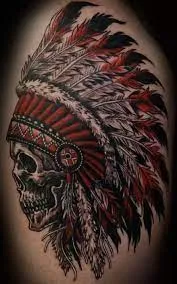
In the world of tattoos, each design etched into the skin tells a story, conveys a message, or carries a deeper meaning. Among the myriad of tattoo motifs, one intriguing combination often depicted in the American traditional style is the skull with the serpent.
This arresting imagery weaves together two powerful symbols – the skull, representing death, and the serpent, a timeless symbol of knowledge and secrecy. In this exploration, we delve into the symbolism behind this gothic tattoo design and uncover the rich layers of meaning it holds.
The American Traditional Style: A Timeless Art Form
Before delving into the symbolism of the skull and serpent, it’s essential to understand the artistic context in which this tattoo style thrives.
The American traditional tattoo style, often referred to as “old school” or “traditional,” has deep roots in the history of tattooing. It emerged in the early 20th century and is characterized by bold outlines, a limited color palette, and iconic imagery. This style has stood the test of time, and its enduring popularity speaks to its timeless appeal.
The Skull: A Universal Symbol of Death
At the heart of the skull and serpent tattoo is the skull itself, a symbol recognized worldwide as a representation of death. It serves as a stark reminder of mortality and the impermanence of life. The skull’s inclusion in this design infuses it with an undeniable element of mortality, acting as a powerful memento mori – a reflection on the inevitability of death.
The Serpent: A Multifaceted Symbol of Knowledge
In contrast to the skull’s association with death, the serpent brings a contrasting layer of symbolism to the tattoo. Serpents have been revered and feared throughout human history, making them a multifaceted symbol. In the context of the skull and serpent tattoo, the serpent represents knowledge, wisdom, and secrecy.
It harkens back to the biblical story of the serpent tempting Eve with the forbidden fruit from the Tree of Knowledge. This act of temptation and the subsequent acquisition of knowledge underscores the serpent’s role as a bearer of hidden truths.
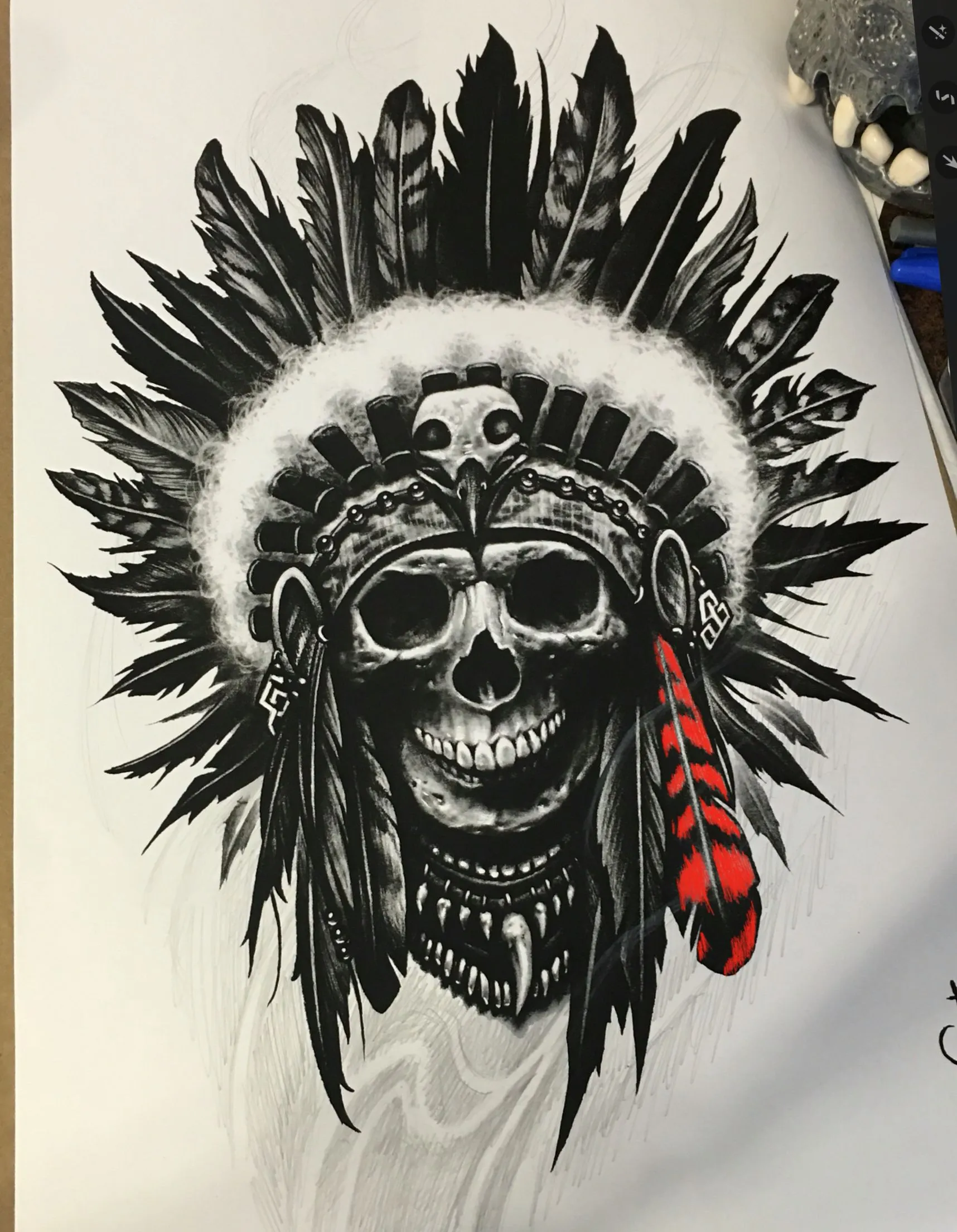
See more: What Is Native American Tattoo Symbols And Meanings?
Persistence Beyond Death: A Gothic Perspective
The combination of the skull and serpent in this gothic tattoo design communicates a profound message – the persistence of knowledge beyond death. It’s a visual representation of the idea that wisdom and secrets endure even in the face of mortality. This imagery suggests that some knowledge transcends the boundaries of life and death, echoing the notion of eternal wisdom.
The Allure of Gothic Symbolism
Gothic symbolism has always held a unique allure. It taps into our fascination with the mysterious, the dark, and the enigmatic aspects of life and death. The skull and serpent tattoo, with its blend of mortality and wisdom, encapsulates this gothic allure, making it a compelling choice for those who are drawn to the deeper mysteries of existence.
In conclusion, the skull with the serpent, often depicted in the American traditional tattoo style, is a symbol that weaves together themes of mortality and wisdom. It serves as a visual reminder of the persistence of knowledge beyond death, offering a unique perspective on the eternal aspects of wisdom. As with all tattoos, its meaning can be deeply personal, resonating with each individual in their own way.
What do tattoos mean to Native Americans?
Tattoos, an art form that transcends time and culture, have been an integral part of human history. Much like the Polynesian islanders, the Native American tribes of North America embraced the art of tattooing, weaving it into the fabric of their culture.
These intricate designs served as more than just body adornments; they were a reflection of achievements, social status, rites of passage, and a profound connection to spiritual beliefs and religious practices. In this exploration, we embark on a journey into the world of Native American tattoos, uncovering their significance and the cultural tapestry they represent.
Embracing Tattooing as a Cultural Tradition
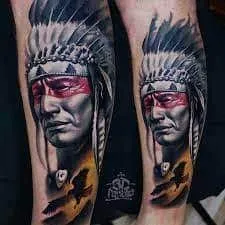
For Native American tribes, tattooing was not merely a decorative practice but a significant cultural tradition. The process of getting a tattoo was a rite of passage, signifying the transition from one life stage to another. It marked the coming of age and was a testament to an individual’s growth within the community.
Symbolism and Spiritual Beliefs
Tattoos held deep symbolic meanings for Native Americans. Each design was carefully chosen to reflect an aspect of the wearer’s life, achievements, or spiritual beliefs. These intricate patterns often conveyed a connection to the natural world, with symbols representing animals, plants, and celestial bodies.
A Silent Language of Identity
Tattoos also served as a silent language of identity within tribes. They conveyed information about a person’s lineage, clan, and tribal affiliations. In essence, one could read a person’s life story through their tattoos, gaining insights into their social standing and cultural heritage.
Spiritual Significance
Beyond their earthly significance, tattoos held profound spiritual meaning. They were seen as a way to connect with the spirit world and seek protection from higher powers. Symbols representing spiritual guides and guardian spirits were common in Native American tattoo designs, serving as a constant reminder of their connection to the divine.
The Challenge of Preserving Tribal Tattoo Knowledge
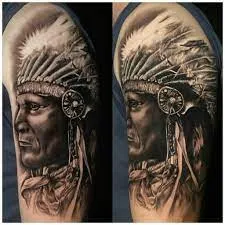
Unfortunately, the knowledge of Native American tattoos faced challenges in preservation. Early European scholars and explorers who encountered Native American tribes did not show significant interest in documenting their tattoo practices. As a result, much of what we know today is derived from a few scattered texts, often based on stories and memories rather than firsthand experiences.
Preserving a Cultural Legacy
Despite these challenges, efforts are being made to preserve and revive the art of Native American tattooing. Tribal members and artists are working together to ensure that this rich cultural legacy lives on. Tattooing has experienced a resurgence in many Native American communities, reaffirming its significance as a cultural treasure.
In conclusion, Native American tattoos are not mere ink on skin; they are a living testament to a vibrant and diverse culture. These intricate designs, steeped in symbolism and tradition, have the power to convey a person’s life story, spiritual beliefs, and tribal identity.
While the challenges of preserving this knowledge persist, the resilience of Native American communities ensures that the art of tattooing remains a cherished part of their heritage, carrying their culture forward for generations to come.
What does a tribal skull tattoo mean?
Skull tattoos have long been an iconic symbol in the world of body art, representing a myriad of meanings across different cultures. Among these, Native American skull tattoos stand out as powerful and deeply meaningful designs, rich in symbolism that pays homage to tradition, ancestry, and strength. In this exploration, we delve into the world of Native American skull tattoos, uncovering their profound significance and cultural resonance.
Native American Skull Tattoos: A Powerful Symbolism
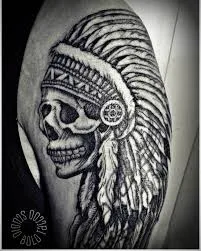
Native American skull tattoos are far more than just ink on skin; they encapsulate a world of symbolism and cultural significance. These designs, often adorned with feathered headdresses, jewels, or even a rose in the eye of the skeleton, convey a range of meanings that resonate deeply with those who wear them.
Wisdom and Respect for Ancestors
At the core of Native American skull tattoos lies the symbolism of wisdom and respect for one’s ancestors. These tattoos serve as a visual reminder of the knowledge and heritage passed down through generations, paying homage to the wisdom of those who came before.
Peace for Mankind
Another profound meaning behind these tattoos is the aspiration for peace among humanity. Native American cultures often held values of unity and harmony with the natural world, and these tattoos reflect that desire for a peaceful existence, both among tribes and with the broader human community.
Power and Strength
Strength is a recurring theme in Native American skull tattoos. The feathered headdresses and fierce imagery symbolize power, resilience, and the ability to overcome challenges. It’s a visual representation of the warrior spirit, resilient in the face of adversity.
An Ode to Native American Ancestry
While many individuals choose these tattoos to pay tribute to their Native American heritage, these designs are not exclusive to any specific group. They are a universal symbol of strength, legacy, and power, resonating with people from all walks of life.
Cultural Variations and Identity
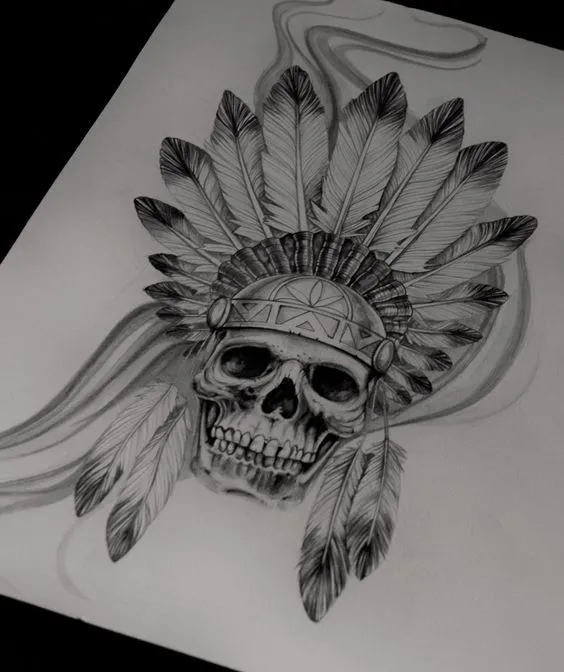
Indian skulls can vary from tribe to tribe, reflecting the diverse cultural tapestry of Native American communities. Each design tells a unique story, conveying the history and identity of the tribe it represents.
The Darker Side of History
It’s essential to acknowledge that the Indian skull tattoo also carries a darker meaning. It serves as a stark reminder of the historical struggles faced by Indigenous tribes, including violence and the forced displacement from their ancestral lands. This somber undertone adds depth to the symbolism of these tattoos.
Expressing Power Through Design
Native American skull tattoos don’t rely solely on vibrant colors for their impact. Dark shading, negative space, bold sketching, and sharp outlines contribute to their visual potency. These designs convey powerful protection and a warrior’s resolve to defend against any threat.
Honoring Ancestors and Warriors
Some individuals choose specific Indian skull tattoos to honor a particular ancestor or Indian warrior within their bloodline. It’s a way to pay tribute to the bravery and legacy of those who walked before them.
A Legacy of American Traditional Tattoos
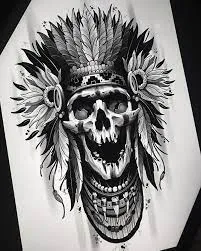
The Indian skull tattoo is deeply rooted in the tradition of American tattoos. Its enduring legacy is a testament to the powerful history and artistry of American tattoo culture.
Exploring Other Skull Tattoo Meanings
Beyond Native American skull tattoos, there are various interpretations of skull imagery in the world of tattoos. Gypsy skull tattoos symbolize freedom, individuality, and a love for travel. When combined with a skull, they often pay tribute to past loved ones who embodied these traits.
Aztec Skull Tattoos: A Complex History
The Aztec skull tattoo delves into the complex history of the Aztec civilization, where human sacrifice was practiced as an offering to the gods. These tattoos convey a sense of awe and respect, signifying that the wearer is not to be trifled with.
In conclusion, Native American skull tattoos are a testament to the enduring power of symbolism in the world of body art. These designs encapsulate wisdom, respect for ancestors, peace, and strength, while also acknowledging the darker chapters of history. Whether as an ode to Native American heritage or a universal symbol of resilience, these tattoos continue to captivate and inspire, making their mark in the tapestry of tattoo culture.
